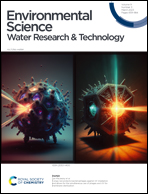Modelling salinity effects on aerobic granular sludge treating fish-canning wastewater†
Abstract
The effect of salinity on aerobic granular sludge treating fish-canning wastewater was evaluated through a one-dimensional biofilm model. Salt inhibition of heterotrophic and nitrifying bacteria was described by a non-competitive inhibition term, for which the value of the half-saturation coefficient was estimated based on data from literature. The model was calibrated and validated with experimental lab-scale data regarding COD and nitrogen removal from industrial wastewater. Two dynamic operating periods with salinities of 13 and 5 g NaCl L−1 were used for calibration and validation, respectively. The prevailing feast–famine regime necessitated simultaneous growth and storage processes to accurately describe COD removal. The presence of salt caused nitrite accumulation, as well as unusually low estimated maximum growth rates of nitrifying bacteria. The addition of a salinity inhibition term to the model could accurately describe the COD and nitrogen species experimentally measured along the cycles with different salinities.



 Please wait while we load your content...
Please wait while we load your content...